-
A bit more Godot work this evening. I wanted to add a foreground layer of tiles that obscured in the player. This is for making false walls to hide secrets around the level. It took me a while to work out how to turn off collision of this foreground layer: there wasn’t really any way to do so within the designer.
Fortunately, this Github comment showing how to do so using a script worked like a charm:
extends TileMap const foreground_layer = 1 func _use_tile_data_runtime_update(layer: int, coords: Vector2i) -> bool: return layer == foreground_layer func _tile_data_runtime_update(layer: int, coords: Vector2i, tile_data: TileData) -> void: tile_data.set_collision_polygons_count(0, 0)Only limitation seems to be that it will disable collision for the whole layer, but that’s perfectly fine with me.
-
Spent more time on my Godot platformer yesterday, mainly rebuilding the first level from scratch. The previous version was rush and was just not fun (it didn’t look good either, but I didn’t dress it up yet). This new one is much nicer, and allowed me to use a few new mechanics I’ve built.
I still need to build out the level ending sequence. I’ve got less than the basics at the moment: a drawbridge descends and that’s pretty much it. I need to add the conditions for when the bridge descends (specifically, a minimum number of coins), stopping the player movement for a brief scripted sequence, then transition to the next level. I think I know how I want to do this, it’s just a matter of implementing it. Once level 1 is dressed up and working, I think that’ll be the next thing I do.
I’m enjoying working on this project so far, although part of me is a little afraid that I’m spending time on something that just isn’t good, like there’s some sunk cost with the time I’m spending on this that’s better put to use on something else. Of course, when I give in to these feelings, I usually just spend the time watching TV. So which activity is the real waste of time? Is producing something that may be crap (or worse, just boring) better than not producing anything at all?
Anyway, not should how this became a feeling post. This game might be rubbish, but I still enjoy working on it: Godot is actually quite fun to use. Surely that is reason enough to continue.
-
Was looking at how I could add hazards to my Godot project, such as spikes. My first idea was to find a way to detect collisions with tiles in a
TileMapin Godot. But there was no real obvious way to do so, suggesting to me that this was not the way I should be going about this. Many suggested simply using anArea2Dnode to detect when a play touches a hazard.I was hesitant to copy and paste the scene node I had which handled the collision signal and kill the player — the so-called “kill zone” scene —but today I learnt that it’s possible to add multiple
CollisionShape2Dnodes to anArea2Dnode. This meant I needed only a single “kill zone” scene node, and just draw out the kill zones over the spikes as children. The TileMap simply provides the graphics.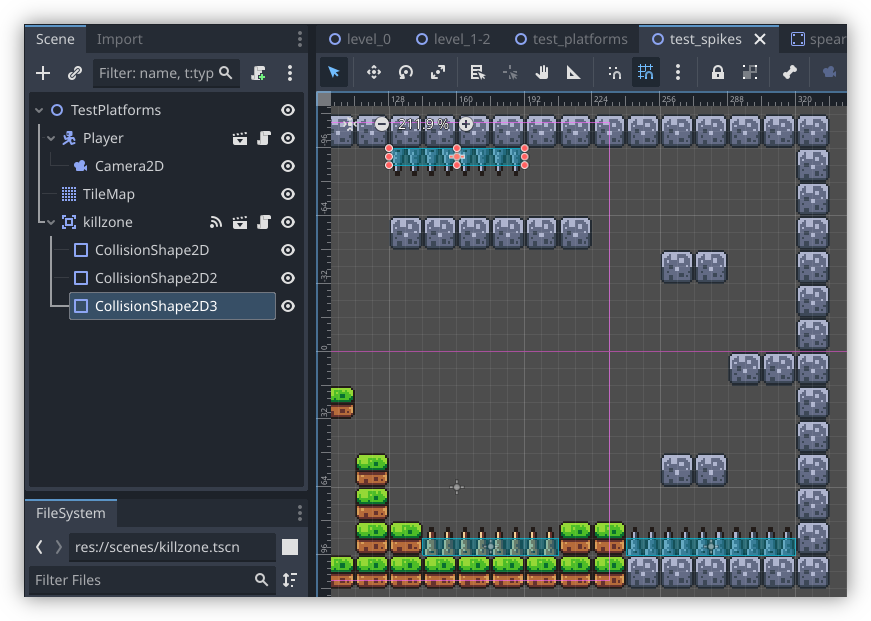
This discovery may seem a little trivial, but I’d prefer to duplicate as few nodes as a can, just so I’ve got less to touch when I want to change something.
-
Tried opening my Godot project this morning and was greeted with the following error:

scene/resources/resource_format_text.cpp:284 - res://scenes/falling_platform.tscn:14 - Parse Error: Failed loading resource: res://scenes/falling_platform.tscn. Make sure resources have been imported by opening the project in the editor at least once. Failed to instantiate scene state of "res://scenes/falling_platform.tscn", node count is 0. Make sure the PackedScene resource is valid. Failed to load scene dependency: "res://scenes/falling_platform.tscn". Make sure the required scene is valid.Traced it back to the technique I was using to respawn the falling platform. Looks like Godot didn’t like the two preloads I included:
# file: scripts/falling_platform.gd @onready var FallingPlatform = preload("res://scenes/falling_platform.tscn") @onready var FallingPlatformScript = preload("res://scripts/falling_platform.gd")This resulted in a parse error and Godot thinking the level scene was corrupted. In retrospect, this kinda makes sense. What I doing was technically a circular dependency, where the scene and script was trying to preload itself. I was hoping Godot was smart enough to recognise this, but I guess not.
So I had to change the respawn code. I modified it to make use the duplicate method. Here’s the revised version:
func respawn(): var dup = self.duplicate() dup.global_position = init_global_position # Duplicate also copies the velocity so zero it out here dup.velocity = Vector2(0, 0) get_tree().current_scene.add_child(dup)After some limited testing, this seems to work. One good thing about this approach is that it looks like duplicate copies the script, so I no longer need to do anything special here.
So I guess the lesson here is don’t try to preload the script within itself.
-
Adventures In Godot: Respawning A Falling Platform
My taste of going through a Godot tutorial last week has got me wanting more, so I’ve set about building a game with it. Thanks to my limited art skills, I’m using the same asset pack that was used in the video, although I am planning to add a bit of my own here and there. But it’s the new mechanics I enjoy working on, such as adding falling platforms. If you’ve played any platformer, you know what these look like: platforms that are suspended in air, until the player lands on them, at which point gravity takes a hold and they start falling, usually into a pit killing the player in the process: Continue reading →
-
Prototyped a game I had in mind, sort of a 2D Sokoban-like thing, where you control a robot with a retractable pushing arm that is to push gems to a “receiver” tile. Not entirely sure if it’s fun enough to actually build.
Used PixiJS to build it. Not a bad framework.
-
Making A Small Two-Letter Country Code Lookup Page
A small evening project where I made a simple site designed for Vivalidi’s sidebar to quickly lookup two-letter country codes defined in ISO-3166-1 alpha 2. Continue reading →
-
Dusted off Podcast Favourites (last commit 25 April 2022) and fixed a longstanding issue of thumbnails being lost when they’re changed in the feed. Editing the feed properties will now force a refresh of the thumbnail URLs. Didn’t need to change anything else, which was a nice change.

-
UCL: Some Updates
Made a few minor changes to UCL. Well, actually, I made one large change. I’ve renamed the foreach builtin to for. I was originally planning to have a for loop that worked much like other languages: you have a variable, a start value, and an end value, and you’d just iterate over the loop until you reach the end. I don’t know how this would’ve looked, but I imagined something like this: Continue reading →
-
Idea for UCL: Methods
I’m toying with the idea of adding methods to UCL. This will be similar to the methods that exist in Lua, in that they’re essentially functions that pass in the receiver as the first argument, although methods would only be definable by the native layer for the first version. Much like Lua though, methods would be invokable using the : “pair” operator. strs:to-upper "Hello" --> HELLO The idea is to make some of these methods on the types themselves, allowing their use on literals and the result of pipelines, as well as variables: Continue reading →
-
UCL: Iterators
Still working on UCL in my spare time, mainly filling out the standard library a little, like adding utility functions for lists and CSV files. Largest change made recently was the adding iterators to the mix of core types. These worked a lot like the streams of old, where you had a potentially unbounded source of values that could only be consumed one at a time. The difference with streams is that there is not magic to this: iterators work like any other type, so they could be stored in variables, passed around methods, etc (streams could only be consumed via pipes). Continue reading →
-
This week’s distraction: building a Wordle clone. No particular reason for doing this other than I felt like building one, although I did miss the small time waster of the original Wordle, and watching a game show with my parents that had a similar concept just made those feelings stronger. Main difference between this and Wordle classic: board randomly selects between 4-letter, 5-letter, and 6-letter words; no daily limit or social-media sharing when you guessed the word correctly; and the biggest one: UK English spelling.
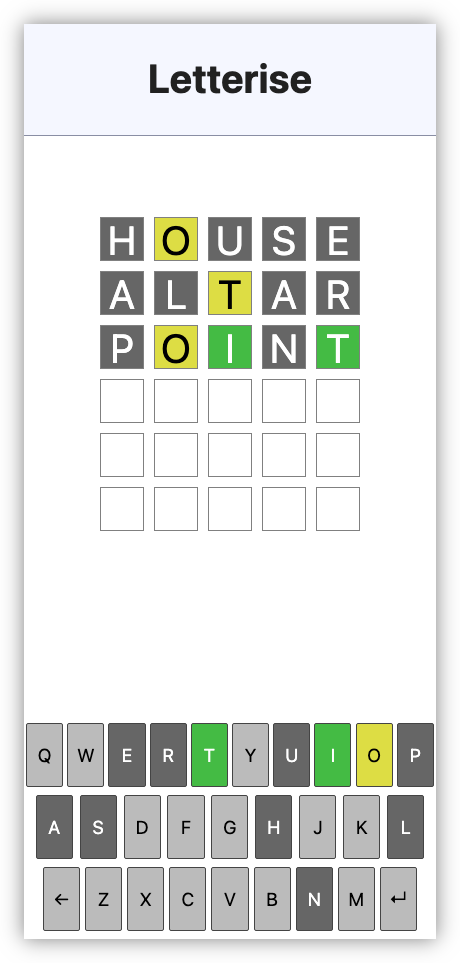
Some remarks on how this was built: I used 11ty to build the static site. It originally started as just a HTML page with some JavaScript, but I wanted to leave the option open for bundling and minifying the JS with Stimulus. The dictionary I got from Hunspell, which is apparently the spell checker Apple has based their work on. There is a little bit of Go to filter and sort the dictionary of words. The words are in sorted order for the binary search algorithm to check if a word exists or not. The puzzle order is predetermined and was done by “shuffling” the indices in a separate array. Base styles are, of course, from simple.css.
If you’re interested in checking it out, you can find it here. Just be aware that it may not be as polished as much of the other stuff you find out there. Turns out that I can tolerate a fair few shortcomings in things that I build for my own amusement.
-
Learnt a very import thing about Stimulus outlets this evening: the outlet name must match the controller name of the outlet target. If this is not the case, the outlet will not bind and you’d be beside yourself struggling to find out why the outlet target cannot be found.
The outlet identifier in the host controller must be the same as the target controller’s identifier.
Took me 30 minutes and stepping through with code with the debugger to find this out.
-
Started filling out the UCL website, mainly by documenting the core modules. It might be a little unnecessary to have a full website for this, given that the only person who’ll get any use from it right now will be myself. But who knows how useful it could be in the future? If nothing else, it’s a showcase on what I’ve been working on for this project.
-
I’ve been using UCL a lot recently, which is driving additional development on it. Spent a fair bit of time this evening fixing bugs and adding small features like string interpolation. Fix a number of grammar bugs too, that only popped up when I started writing multi-line scripts with it.
-
Project Update: DSL Formats For Interactive Fiction
Still bouncing around things to work on at the moment. Most of the little features have been addressed, and I have little need to add anything pressing for the things I’ve been working on recently. As for the large features, well apathy’s taking care of those. But there is one project that is tugging at my attention. And it’s a bit of a strange one, as part of me just wants to kill it. Continue reading →
-
I recently got a new phone, a Pixel 9 Pro, which meant I needed to bring Alto Player up to date. I probably could’ve gotten away using the version I was using on my Pixel 6. But I didn’t have a binary build, and I needed to upgrade Gradle anyway, so I decided to spend a bit of time bringing it up to date to API version 35, the version used in Android 15.0. Fortunately it was only a few hours in total, and once I got it running in the simulator, I side-loaded it onto my phone and started using it.
It worked, but there were some significant UI issues. The title-bar bled into the status bar, the album image in the Now Playing widget was cropped by the curved corners of the phone, and the media notification didn’t display playback controls.
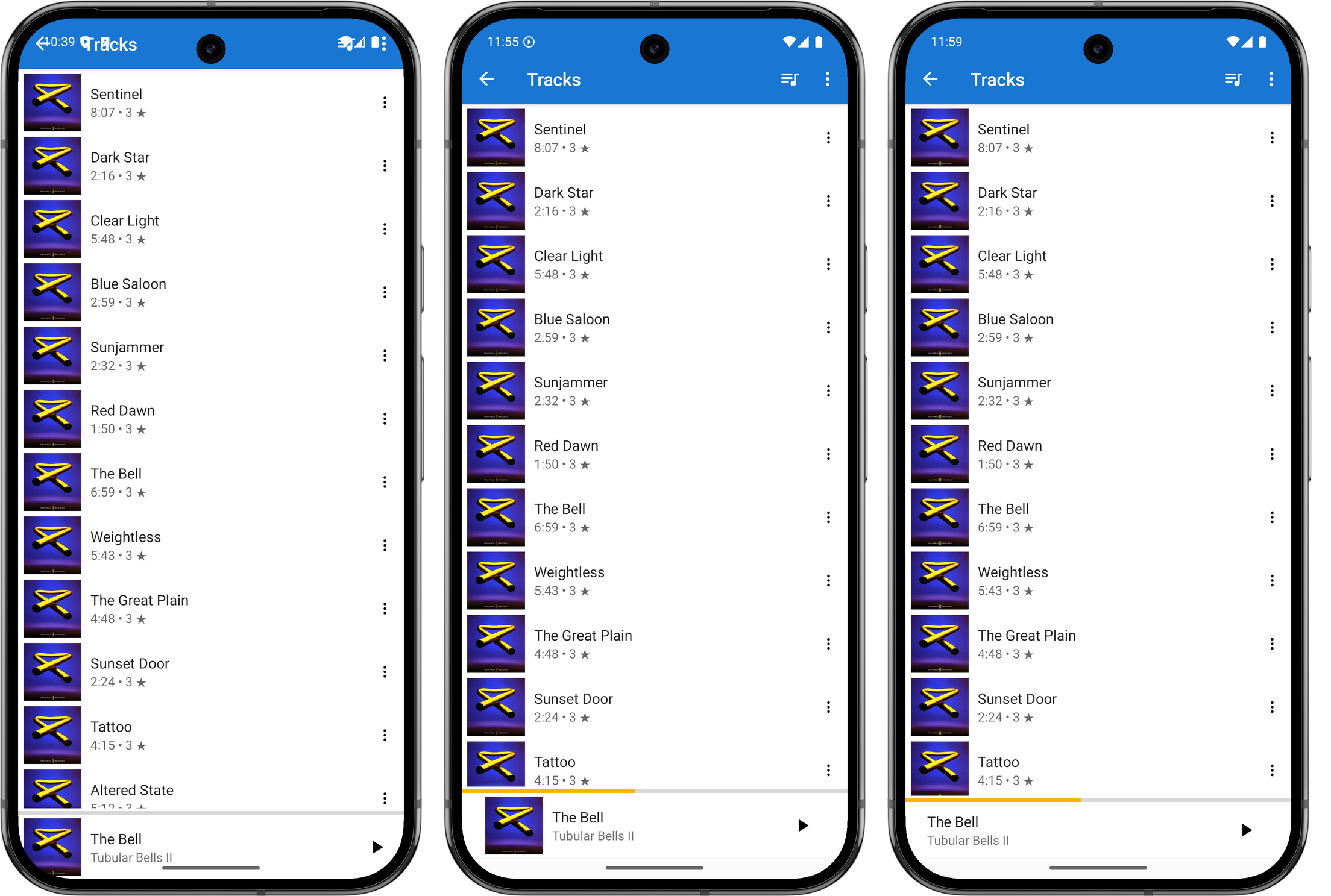
Evolution of the window insets, from left-to-right: before any changes, version with the album cover and margin, final version with no album art. I set about fixing these issues today, starting with the title-bar and Now Playing widget. These was an issue with the views not respecting the window insets, and after a quick Google search, I found this article showing how one could resolve this by adding a ViewCompat.setOnApplyWindowInsetsListener and reacting to it by adjusting the margins of the view.
val topLevelLayout = findViewById(R.id.top_level_layout) as CoordinatorLayout ViewCompat.setOnApplyWindowInsetsListener(topLevelLayout) { v, windowInsets -> val insets = windowInsets.getInsets(WindowInsetsCompat.Type.systemBars()) v.updateLayoutParams<ViewGroup.MarginLayoutParams> { leftMargin = insets.left bottomMargin = insets.bottom rightMargin = insets.right // applying a top margin here would work, but will not have the toolbar // background colour "bleed" into the status bar, which is what I want. } val t = v.findViewById<Toolbar>(R.id.toolbar) t.updateLayoutParams<ViewGroup.MarginLayoutParams> { // make the toolbar a little "narrower" than full height topMargin = insets.top * 3 / 4 } WindowInsetsCompat.CONSUMED }It took a few attempts, but I managed to get this working. Just using the top inset for the toolbar margin made it a little larger than I liked, so I adjusted the height to be 75% of the inset. This means the toolbar will actually encroach into the area reserved for cut-outs like the front-facing camera. This is arguably not something a “real” Android apps should do, but this is just for me and my phone so it’s fine.
I went through a few iterations of the album artwork cutoff on the bottom right corner trying to find something I liked. I tried bringing in the horizontal margins a little, but I didn’t like the alignment of the album art in the player, particularly compared to the covers that appear in the track list screen. One thing I didn’t try was raising the bottom margin so that it would fit “above” the curve. But those corners curve in quite a bit, and doing this would sacrifice a lot of vertical space. So I settled on hiding the album art altogether. It’s a bit of a shame to loose it, but at least it looks neater now.
The next thing I looked at was fixing the playback controls in the media notification. After some investigating, I found that this was because I was not setting the available actions in the PlaybackStateCompat builder. This, if I understand correctly, is used to communicate to various systems the current state of the playing media: what the track name is, whether it’s playing, whether one can skip forward or back. I have my own types for tracking this information — which is probably not correct but I wasn’t completely sure as to what I was doing at the time with Android’s media stack1 — and when I needed to convert this to a type understood by the framework, I made instances of this builder without setting the available actions. Earlier versions of Android seemed not to care, and the controls always appeared on the notification. But I guess they changed that.
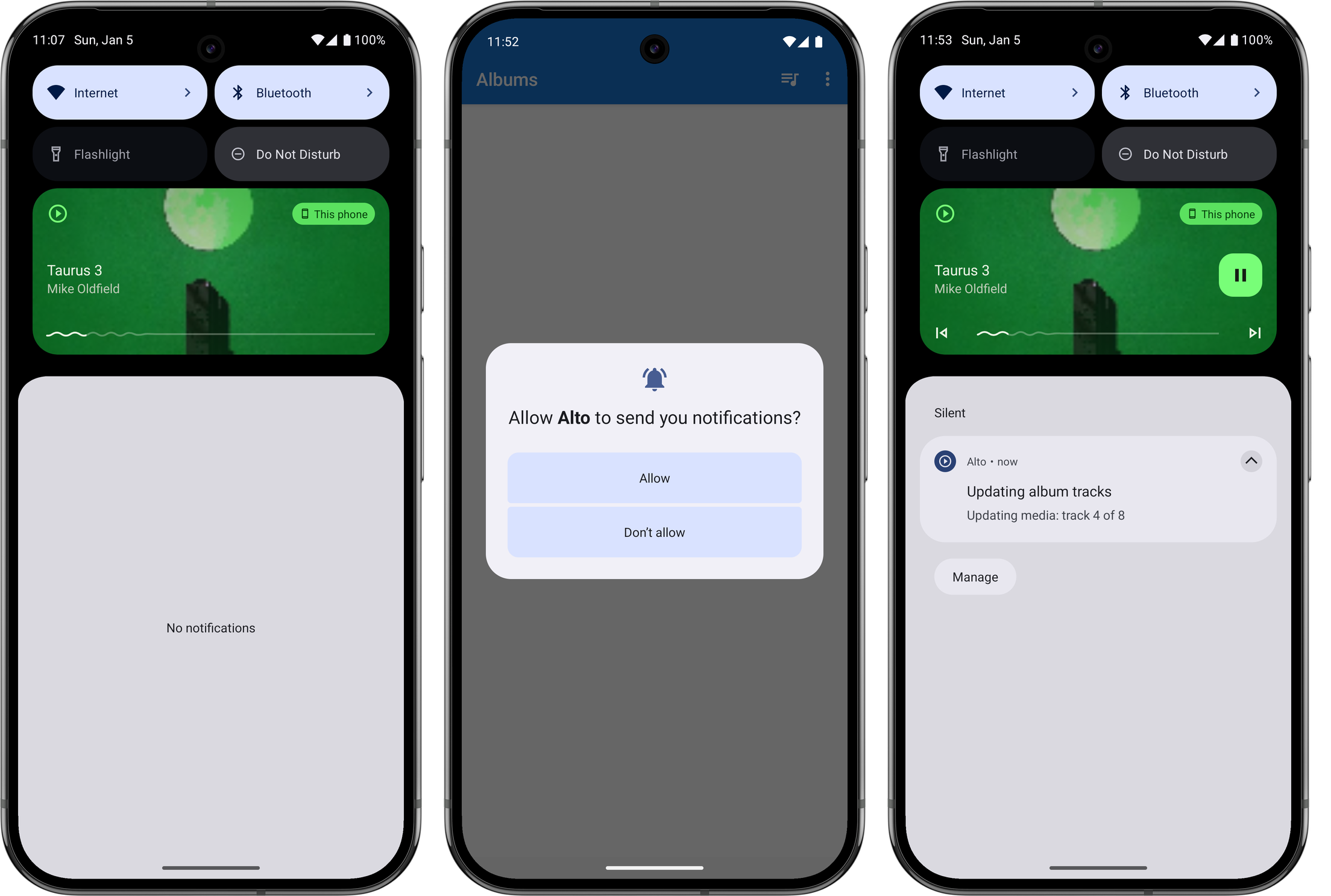
Evolution of the playback notification, from left-to-right: before any changes, the request to show notifications upon first launch (this is defined by the system), the playback notifications with controls again. One other thing I needed to do was to explicitly ask the user permission to show a notification before I could publish one. This is also relatively new: my experience with Android goes back to the early days where these permissions were disclosed up front when the app was installed. But I can completely understand why they changed it, as it was easy to simply tap through those screens with reading them. I am wondering whether media playback notifications are in some way exempt from these permission checks, as I was actually getting one to appear before I made this changes. But I figured it was probably worth doing anyway, so I added this permission request on first launch. Arguably I should be asking for this permission when playback starts, but again, this is just for me.
One final thing I needed to address were long album titles. The text view displaying the the album title had a width that autosized to the title itself, and the start and end constraints were set such that it appears centred in the view. This worked for “normal” length titles but when the length became excessive, the text view would fill the entire width of the screen and the title will appear left justified.
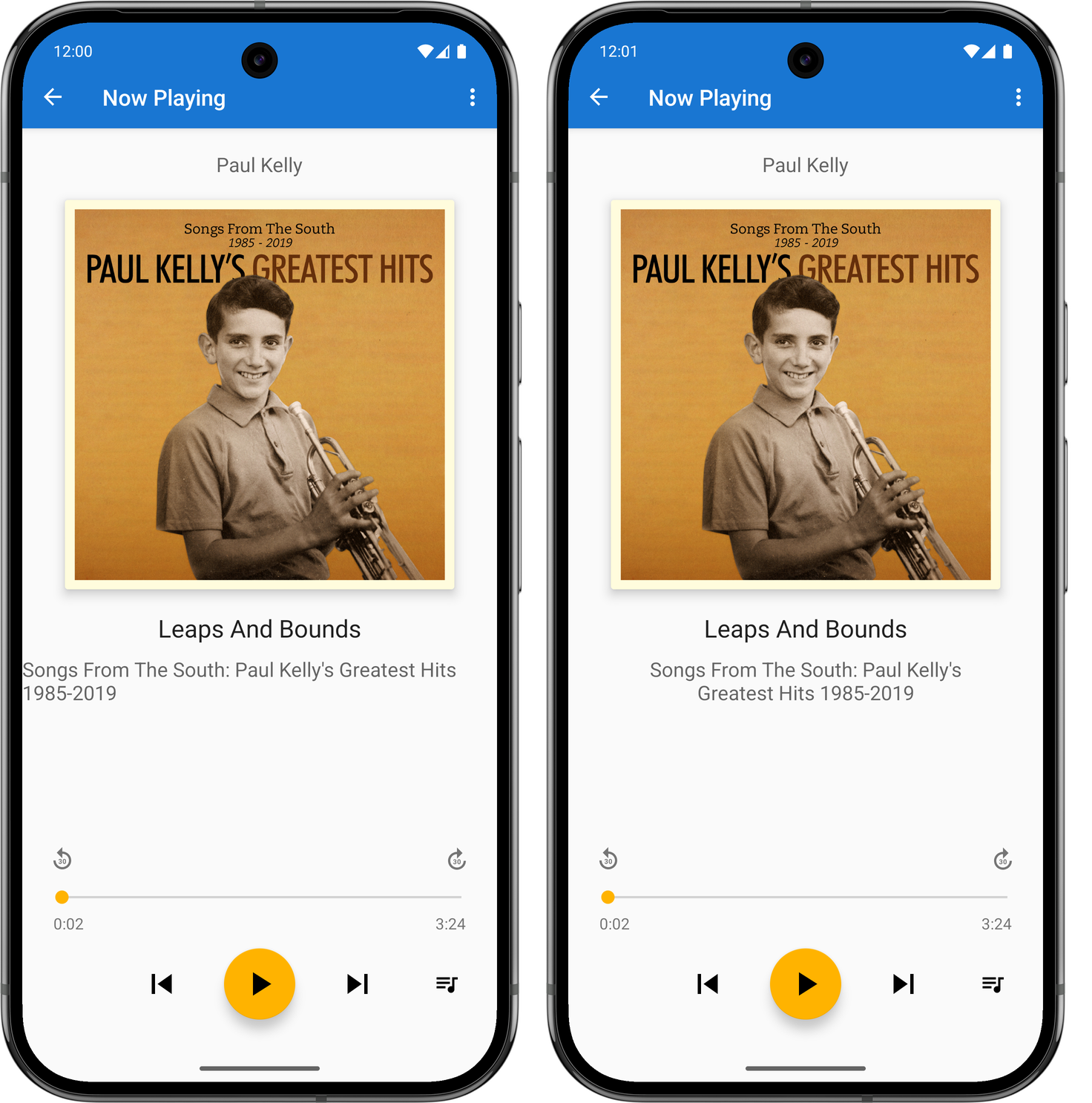
Before (left) and after (right) shot of the fixed album title. The fix for this was to set the text width to be calculated by the start and end constraints (setting
layout_widthto0dp), bringing in the margins a little, and making the label text centre justified. I did this already for the track title, so it was easy to do this here too. Not sure why I didn’t do it earlier, or why I haven’t done it for the artist’s name yet.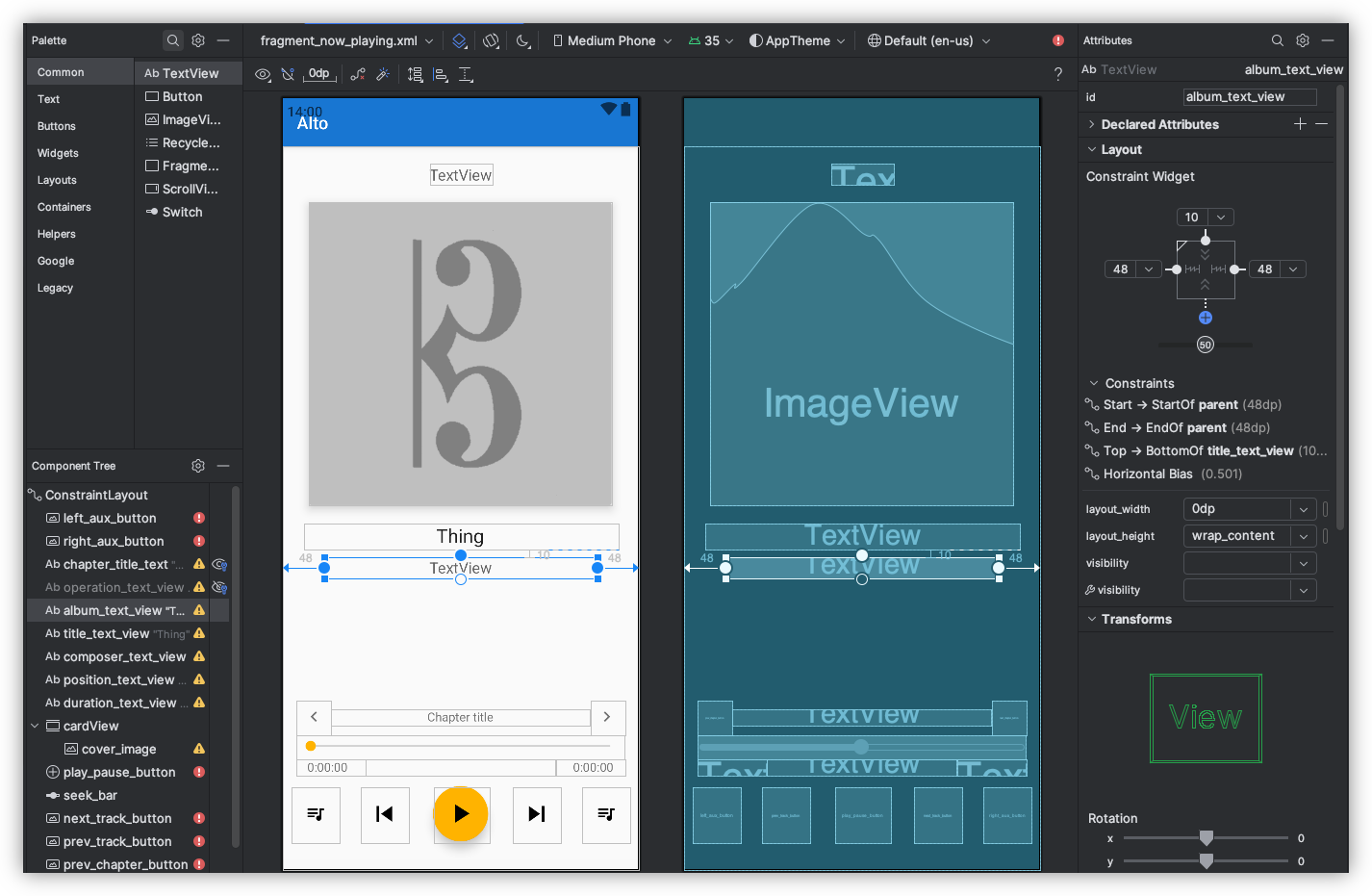
This was all rushed, and I’ll admit I wasn’t 100% sure what I was doing. I was going down the route of trial-and-error to get this working, mixed in with web searches and a trip to ChatGPT. And yeah, the methods I used won’t make this a portable Android app that would work on every phone out there. But I’m reasonably happy with how it turned out.
-
This is still true to this day. ↩︎
-
-
Thanks for my new found fondness of buying mainstream music instead of streaming it, I needed a way to get these albums into Alto Catalogue. There exists a feature for fetching and importing tracks from a Zip referenced by a URL. This works great for albums bought in Bandcamp, but less so for any tracks I may have on my local machine.
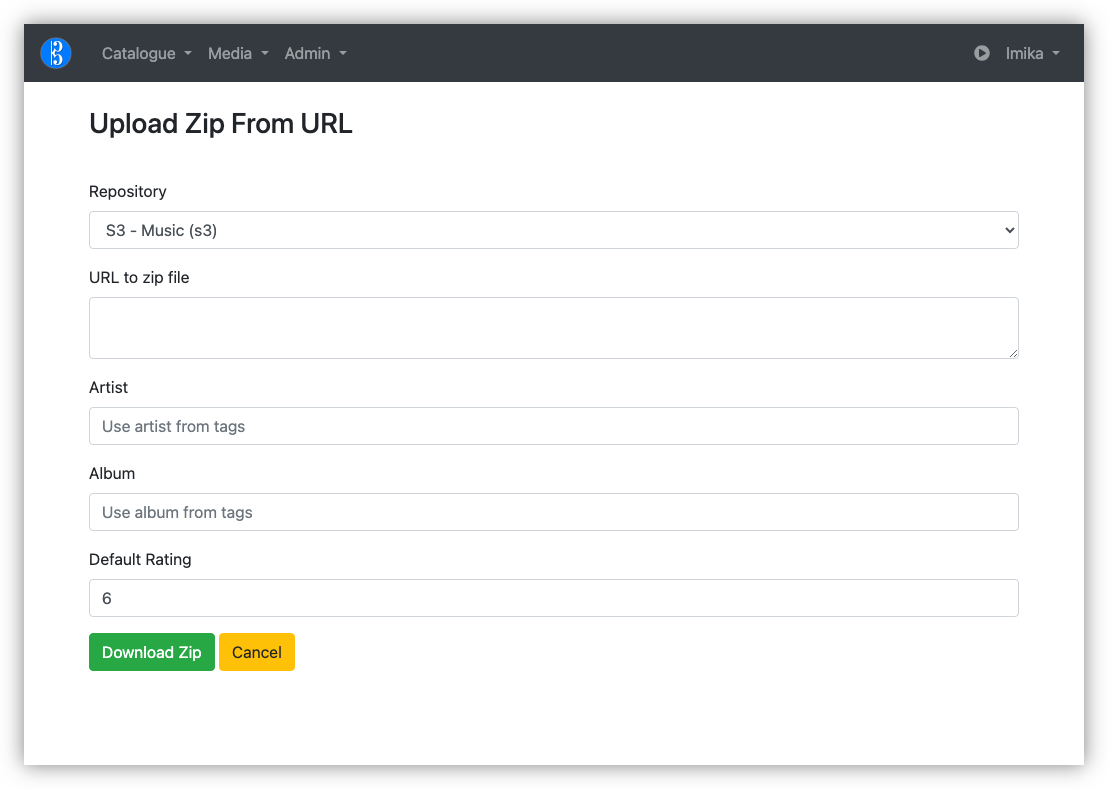
I’ve managed to get Alto Catalogue building again after updating Webpack and a few NPM packages, so in theory, I could add an Upload Zip file action. But there’s more to this than simply accepting and unpacking a Zip file. I have to read the metadata, maybe even preview the tracks that will be imported, just in case I’m importing something I rather not (I did see this once, where zipping a bunch of tracks in the Finder introduced duplicates). This already exists for Zip files that are downloadable online.
I had a though about what my options are, until I remembered that I had a Gokapi instance running in Pikapods. So I tried using that to temporarily host the Zip file with a publicly available URL that could be read by Alto Catalouge.
The only problem is my internet upload speed is sooooo sloooooow. The Gokapi instance is hosted in Europe, and I suspect the instance itself is a little underpowered. So uploading 100 MB Zip files would take a fair bit of time: maybe 15-30 minutes. When I tried doing this via the web frontend, the connection timed out.
Fortunately, Gokapi has an API and one of the methods allows you to upload a file in “chunks,” which Gokapi will assemble back into the original file. Even better is that this chunking can be uploaded in parallel.
So I built a CLI tool which made of this chunking API to upload the Zip files. Once the upload is complete, the tool will display the hot-link URL, which I can copy-and-paste into Alto Catalogue.
The whole process isn’t fast (again, slow upload speeds). But it works, and I can use this tool to queue a bunch of uploads and let it do its thing while I’m doing something else. I really like tools that do this, where you’re not forced to babysitting them through the process.
There are a few limitations with it. It doesn’t allow for an awful lot of customisations on the lifecycle of the uploaded file. And the tool stalled out once when my computer went to sleep, and I had to start the upload from scratch. I could probably add something to track the chunks that were successful, allowing one to continue a stalled upload. If this happens frequently, I may look more into adding this.
But even so, this could be a useful addition to my use of Gokapi for transferring temporary files. If you think this might be useful to you, you can find the tool here.
-
Fixed the UI of Alto Player, plus addressed some long standing issues I’ve been having.
One was displaying the album covers for playlists instead of the generic “missing album” image. It’s technically possible to set an album cover on a playlist, but I never built the UI to do this in the web-app. So the app now uses the album cover of the first track in the playlist if one isn’t specified. Another was getting automated release builds working in GitHub, as per these instructions
But the biggest improvement was finally getting around to storing the position of the album list, so that going back up the navigation stack wouldn’t reposition the list to the top. I tried this a way back, but couldn’t get it working, probably because I was testing
RecyclerView.scrollToPositionWithOffsetby passing last constant numbers, like 100, only to find the list not actually scrolling. It turns out that this method actually takes the index of the item to position at the top, not a pixel offsets. So the view wouldn’t scroll if you happen to have a list with less than 100 items. It only started working after I tried smaller numbers, like 5.So all in all, a good day.
-
Only took two hours to uplift Alto Player from Android SDK version 30 to 35. Fought an upgrade to Gradle (because of-course), skirted around a migration from ExoPlayer to Media 3, and battled a NullPointerException due to my inability to properly my own navigation args. All in all, not bad.
-
More fun today working on Blogging Tools. Finished a feature for uploading larger videos to object storage so they can be added to a post using the standard video tag, as opposed to an embedded video player. If you see the screencast below, that means it’s working.
-
Exploring Godot to see if I could use it to make a card game. I got this far:
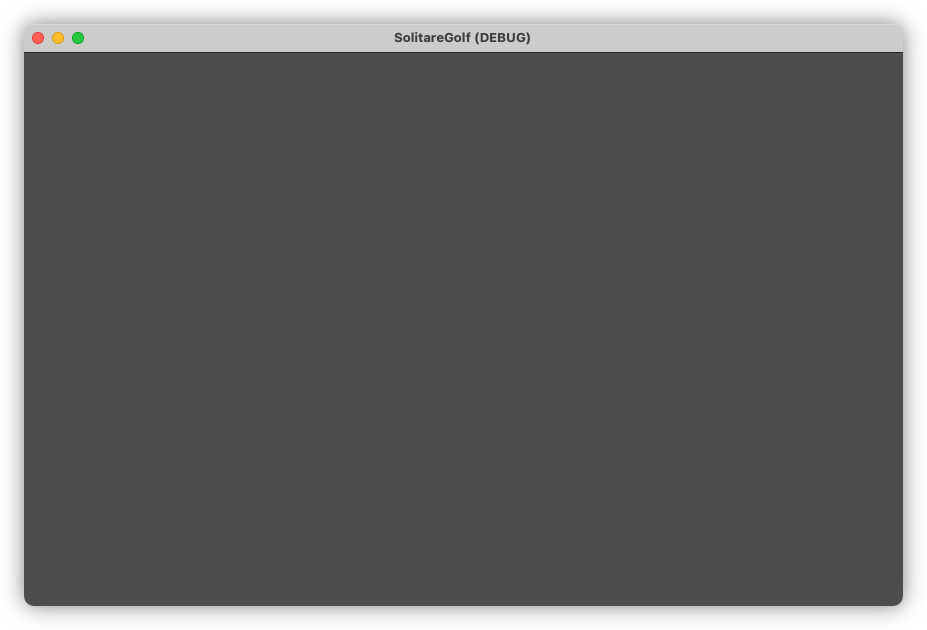
Yep, I’m on a roll. 😄
Might need to work through a couple Godot tutorials first, just so that I understand the basics.
-
I plan to integrate UCL into another tool at work, so I spent last night improving it’s use as a REPL. Added support for onboard help and setting up custom type printing, which is useful for displaying tables of data. I started working on the tool today and it’s already feeling great.
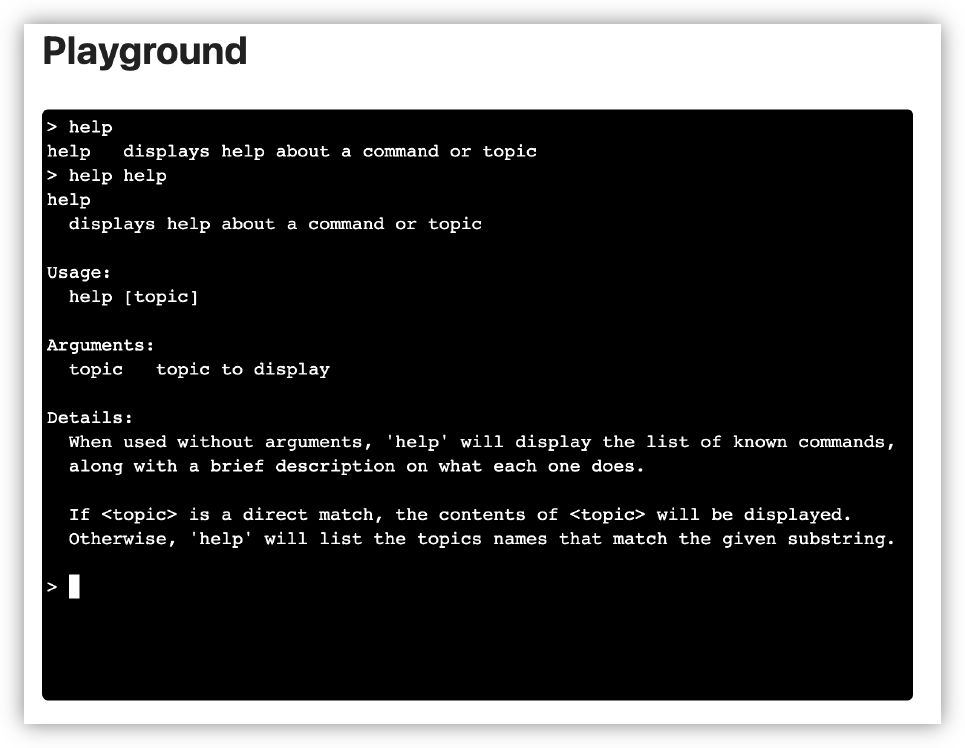
-
In other building-small-things-for-myself news, I spent a bit of time this morning on the image processor for Blogging Tools. The big new change was adding support for working with multiple source images, instead of just one. This made way for a new “Phone Shot” processor, which arranges multiple screenshots of phone apps in a row, while also downscaling them and proving some quick crops and distribution options.
This should reduce the vertical size of mobile app screenshots I post here, something that’s been bothering me a little.
-
Some more work on that feed reader app. You know how I said that I wanted to hold off looking at appearances? Well, I abandoned that approach when I installed the app on my phone and tried viewing a few articles. And oof! There’s work to be done there.
First, it’s slow. Very slow. It’s taking a good second or two to pull feeds and entries from Feedbin. I was expecting this, and I’ve got a few plans on how to speed this up. But the biggest concern is the janky list scrolling. I mean, I wasn’t expecting the buttery smoothness of iPhone list scrolling, but I expected Flutter to be better than what I was experiencing. I’m hoping that it’s just because I was running a debug build, but part of me fears that Flutter is just not optimised for smooth list scrolling, favouring ease of development and a common runtime. I rather not change frameworks now, especially after spending an evening dealing with all the build issues, but I don’t want to live with this for ever.
But speed is not the biggest issue. The biggest offender was the feed reader view. The embedded web-view was only lightly styled, and it felt like it. The margins were all off, and I didn’t like the default font or colours. It made reading the article a bad experience to a surprising degree. I’ve dealt with rushed or poorly designed UIs in the past, but I didn’t have much tolerance for this. Not sure why this is, but I suspect it’s because I’ve been using feed readers that put some effort into the design of their reader screen.
In any case, a couple of evenings ago, I decided to put some effort into the styling. I replace the body text font with Noto Sans and the fixed-font with Ubuntu Mono. I dropped the font-size a little to 1.05 em (it was previously 1.1 em, with felt a little big, and 1.0 em felt a little small). I bought the margins in a little. And I styled the block-quote, figure, and pre elements to an appearance that, despite being a little overused, felt quite modern.
The results look much better, at least to my eye (and my emulator). Here are some side-to-side comparison shots of the changes (left side is the unstyled version, while the right side has the new styling changes):
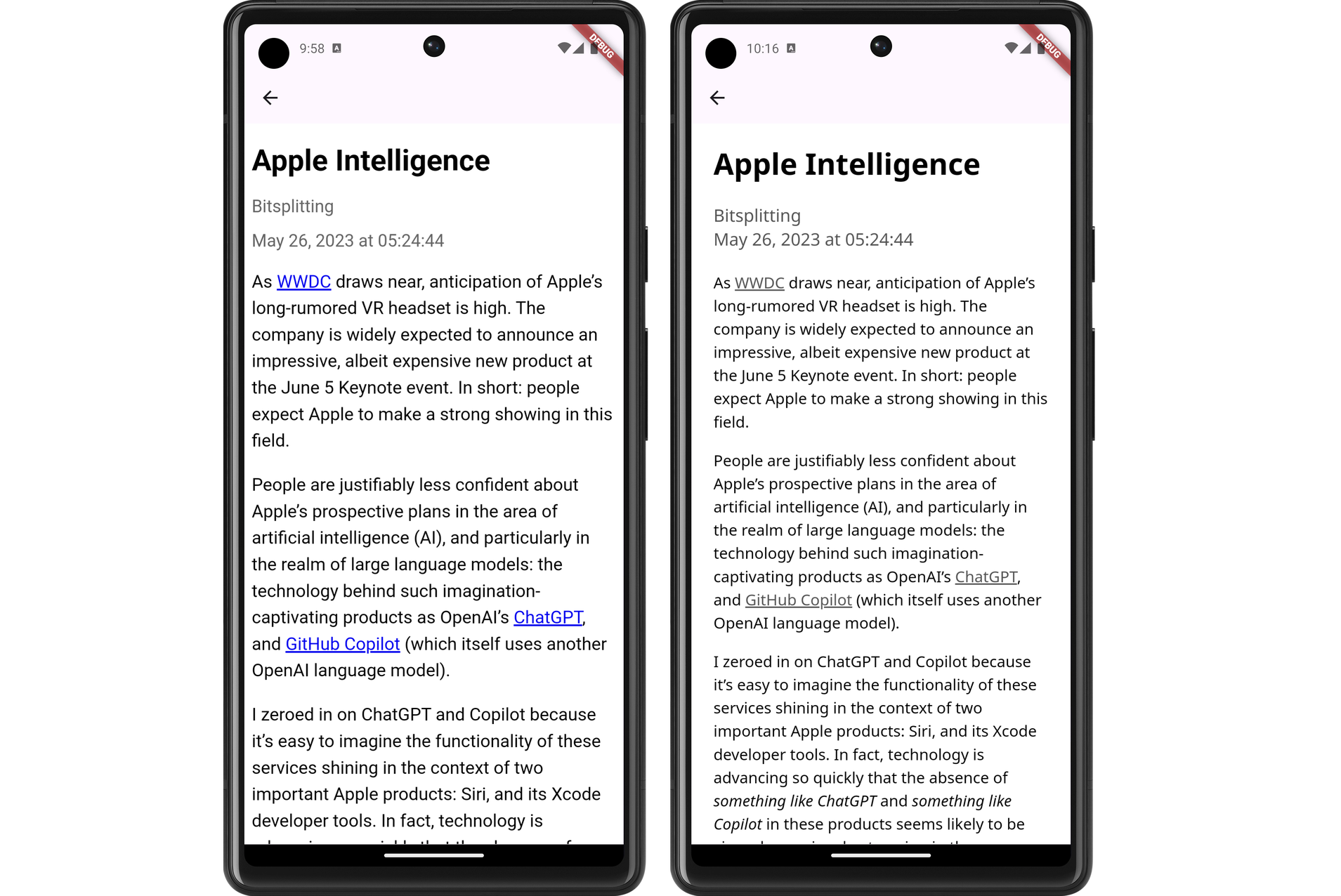
Demonstration of the new font and link colouring choices. 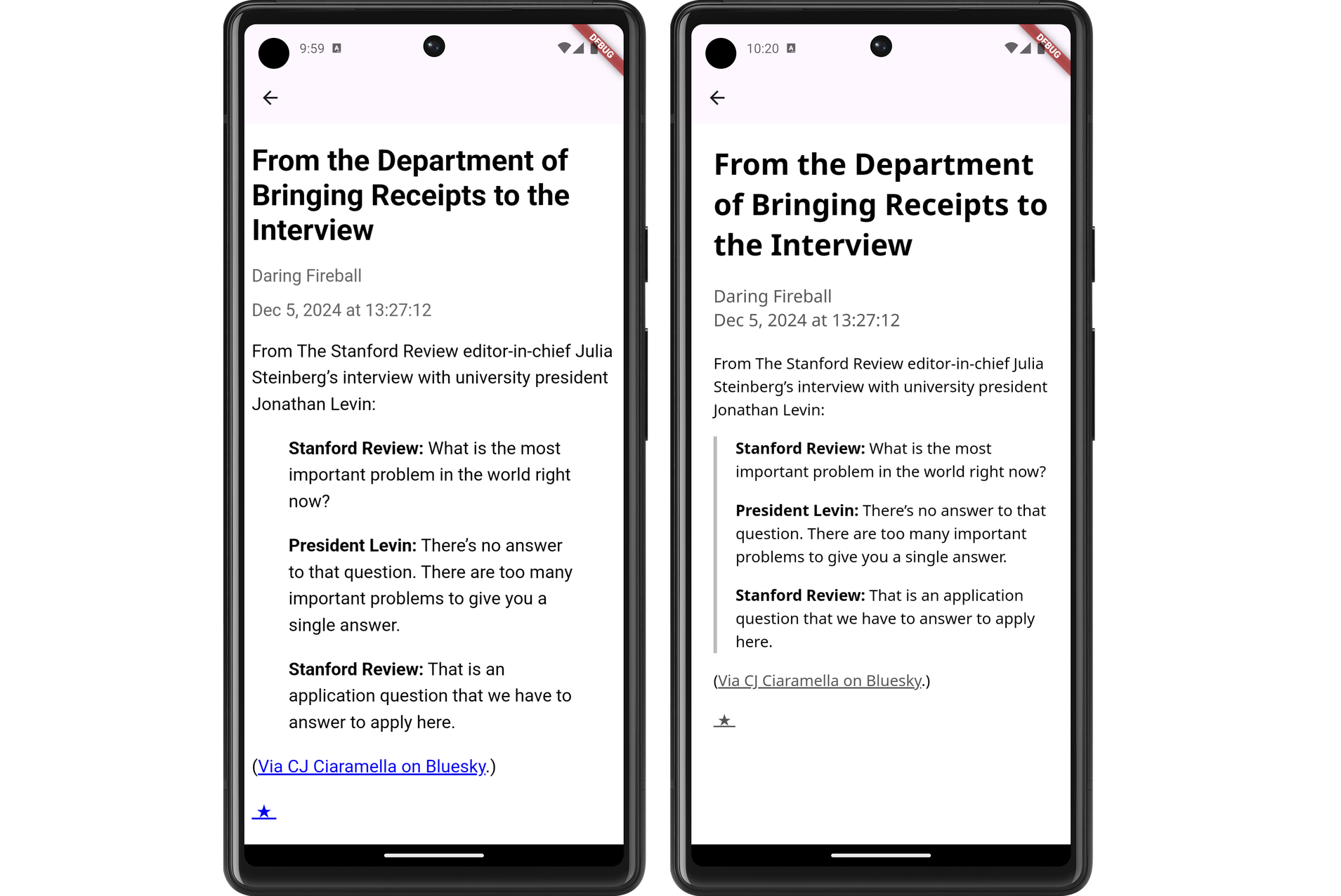
Demonstration of the changes to block-quotes. Having a line down the left-sided is a pretty common style, but it's one I like. 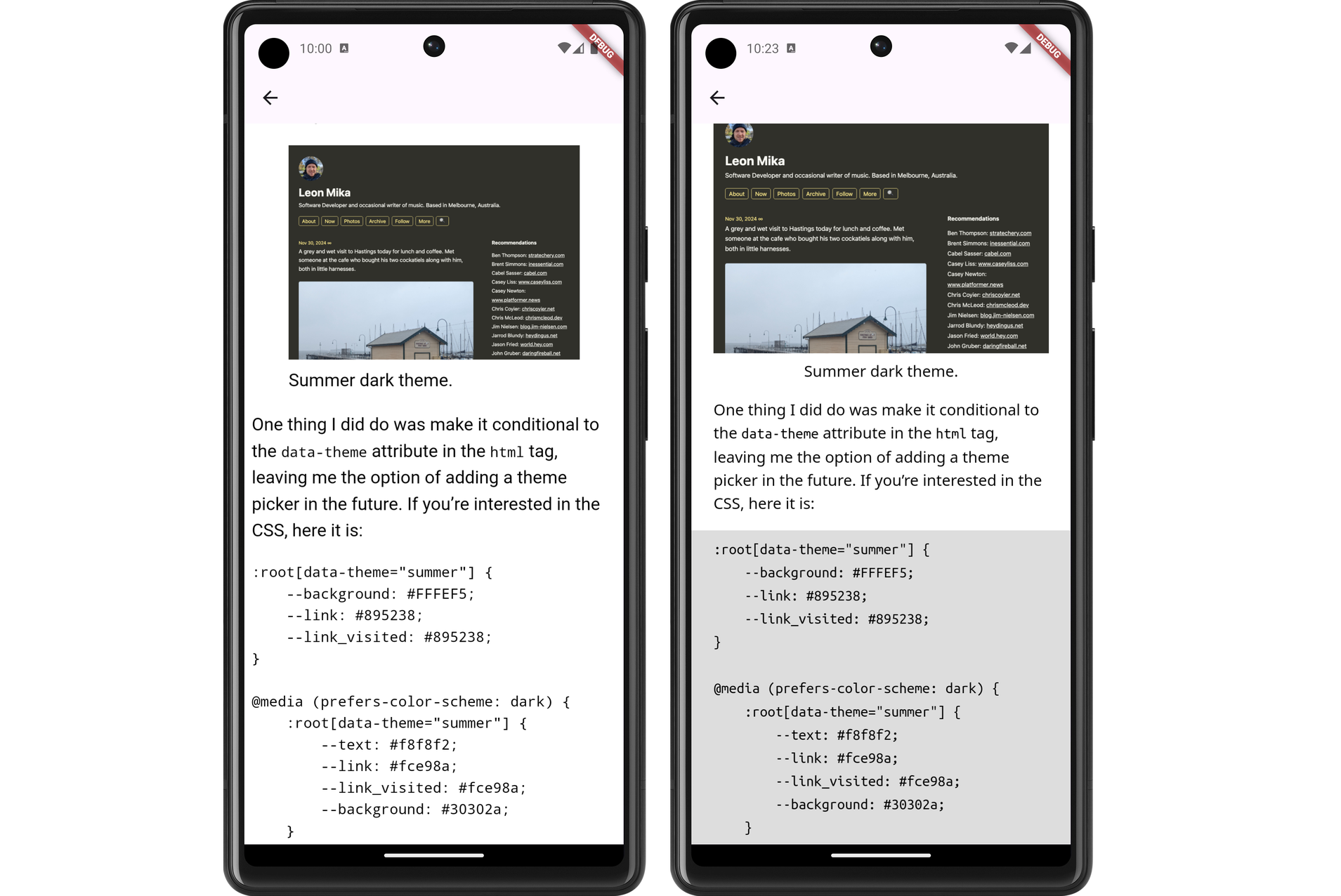
Demonstration of code blocks and figures with captions. I still need to actually install this on my phone and try it out. I’m wondering whether I should do so after a bit more work syncing the read status with Feedbin. That’s a feature that’s keeping me on Feedbin’s PWA for now.